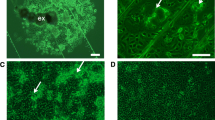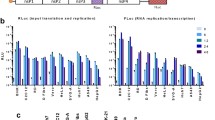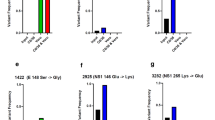Abstract
Mosquitoes are generally considered one of the most important vectors of arboviruses, with Aedes aegypti regarded as the most important in transmission of yellow fever and dengue viruses. To investigate why there are differences in the incidence of dengue fever and Zika in different geographical areas and an absence of outbreaks in Ghana in spite of an abundance of A. aegypti mosquitoes, we established a continuous cell line from embryonic cells of A. aegypti collected in Ghana and assessed its susceptibility to dengue, yellow fever, and Zika viruses. The new cell line (designated AeAe-GH98), having an adhesive spindle-shaped web-like morphology, was serially subcultured in both VP-12 and Schneider’s medium supplemented with 10% heat-inactivated fetal bovine serum. AeAe-GH98 cells were found to have a population doubling time of 1.3 d during exponential growth. The mosquito colony used to establish the cell line was confirmed to have originated from Africa using microsatellite assay. In terms of susceptibility to Aedes-borne flaviviruses, AeAe-GH98 cells were found to have different degrees of susceptibility to yellow fever, Zika, and dengue virus infection and propagation. While susceptibility of AeAe-GH98 cells to yellow fever and Zika viruses was comparable with that of C6/36 cells, susceptibility to dengue virus was significantly lower. This cell line will serve as a useful tool for determining molecular factors influencing virus–vector susceptibility in vitro.





Similar content being viewed by others
References
Amoako N, Duodu S, Dennis FE, Bonney JHK, Asante KP, Ameh J, Mosi L, Hayashi T, Agbosu EE, Pratt D, Operario DJ, Fields B, Liu J, Houpt ER, Armah GE, Stoler J, Awandare GA (2018) Detection of dengue virus among children with suspected malaria, Accra, Ghana. Emerg Infect Dis 24:1544–1547
Amoa-Bosompem M, Kobayashi D, Murota K, Faizah NA, Itokawa K, Fujita R, Osei JHN, Agbosu E, Pratt D, Kimura S, Kwofie DK, Ohashi M, Bonney JHK, Dadzie S, Sasaki T, Ohta N, Isawa H, Sawabe K, Iwanaga S (2020) Entomological assessment of the status and risk of mosquito-borne arboviral transmission in Ghana. Viruses 12(2):147
Appawu M, Dadzie S, Abdul H, Asmah H, Boakye D, Wilson M, Ofori-Adjei D (2006) Surveillance of viral hemorrhagic fevers in Ghana: entomological assessment of the risk of transmission in the northern regions. Ghana Med J 40:137–141
Barletta ABF, Silva MCLN, Sorgine MHF (2012) Validation of Aedes aegypti Aag-2 cells as a model for insect immune studies. Parasit Vectors 5:148
Bonney JHK, Hayashi T, Dadzie S, Agbosu E, Pratt D, Nyarko S, Asiedu-Bekoe F, Ido E, Sarkodie B, Ohta N, Yamaoka S (2018) Molecular detection of dengue virus in patients suspected of Ebola virus disease in Ghana. PLoS One 13:e0208907
Brown JE, McBride CS, Johnson P, Ritchie S, Paupy C, Bossin H, Lutomiah J, Fernandez-Salas I, Ponlawat A, Cornel AJ, Black WC IV, Gorrochotegui-Escalante N, Urdaneta-Marquez L, Sylla M, Slotman M, Murray KO, Walker C, Powell JR (2011) Worldwide pattern of genetic differentiation imply multiple ‘domestications’ of Aedes aegypti, a major vector of human diseases. Proc R Soc B 278:2446–2454
Clements AN (1992) The biology of mosquitoes Vol 1. Development Nutrition and Reproduction. CABI Publishing, Wallingford, CT
Conway MJ, Colpitts TM, Fikrig E (2014) Role of the vector in arbovirus transmission. Annu Rev Virol 1:71–88
Fredericks AC, Russel TA, Wallace LE, Davidson AD, Fernandez-Sesma A, Maringer K (2019) Aedes aegypti (Aag2)-derived clonal mosquito cell lines reveal the effects of pre-existing persistent infection with the insect-specific bunyavirus Phasi Charoen-like virus on arbovirus replication. PLoS Negl Trop Dis 13(11):e0007346
Freshney RI (2005) Culture of animal cells: a manual of basic techniques, 5th edn. Wiley and Sons, Inc., Hoboken, NJ
Gloria-Soria A, Ayala D, Bheecarry A, Calderon-Arguedas O, Chadee DD, Chiappero M, Coetzee M, Elahee KB, Fernandez-Salas I, Kamal HA, Kamgang B, Khater EI, Kramer LD, Kramer V, Lopez-Solis A, Lutomiah J, Martins A Jr, Micieli MV, Paupy C, Ponlawat A, Rahola N, Rasheed SB, Richardson JB, Saleh AA, Sanchez-Casas RM, Seixas G, Sousa CA, Tabachnick WJ, Troyo A, Powell JR (2016) Global genetic diversity of Aedes aegypti. Mol Ecol 25(21):5377–5395
Hoshino K, Isawa H, Kuwata R, Tajima S, Takasaki T, Iwabuchi K, Sawabe K, Kobayashi M, Sasaki T (2015) Establishment and characterization of two new cell lines from the mosquito Armigeres subalbatus (Coquillett) (Diptera: Culicidae). In Vitro Cell Dev Biol-Animal 51:672–679
Inoue H (1989) Establishment of insect continuous cell lines and its utilization for virus multiplications in vitro. Japan Agricultural Research Quarterly 23(1):31–36
Itokawa K, Hu J, Sukehiro N, Tsuda Y, Komagata O, Kasai S, Tomita T, Minakawa N, Sawabe K (2020) Genetic analysis of Aedes aegypti captured at two international airports serving to the Greater Tokyo Area during 2012–2015. PLoS One 15(4):e0232192
Jombart T (2008) adegenet: a R package for the multivariate analysis of genetic markers. Bioinformatics 24(11):1403–1405
Jombart T, Devillard S, Balloux F (2010) Discriminant analysis of principal components: a new method for the analysis of genetically structured populations. BMC Genet 11:94
Kanthong N, Laosutthipong C, Flegel WT (2010) Response to dengue virus infections altered by cytokine-like substances from mosquito cell cultures. BMC Microbiol 10:290
Kobayashi D, Ohashi M, Osei JHN, Agbosu E, Opoku M, Agbekudzi A, Joannides J, Fujita R, Sasaki T, Bonney JHK, Dadzie S, Isawa H, Sawabe K, Ohta N (2017) Detection of a novel putative phlebovirus and first isolation of Dugbe virus from ticks in Accra, Ghana. Ticks Tick Borne Dis 8:640–645
Kuno G (2007) Host range specificity of flaviviruses: correlation with in vitro replication. J Med Entomol 44(1):93–101
Kuwata R, Hoshino K, Isawa H, Tsuda Y, Tajima S, Sasaki T, Takasaki T, Kobayashi M, Sawabe K (2012) Establishment and characterization of a cell line from the mosquito Culex tritaeniorhynchuis (Diptera: Culicidae). In Vitro Cell Dev Biol-Animal 48:369–376
Liang G, Gao X, Gould EA (2015) Factors responsible for the emergence of arboviruses; strategies, challenges and limitations for their control. Emerg Microbes Infect 4:e18
Lynn DE (1999) Development of insect cell lines: virus susceptibility and applicability to prawn cell culture. Methods Cell Sci 21:173–181
Messina JP, Brady OJ, Scott TW, Zou C, Pigott DM, Duda K, Bhatt S, Katzelnick L, Howes RE, Battle KE, Simmons CP, Hay SI (2014) Global spread of dengue virus types: mapping the 70 year history. Trends Microbiol 22(3):138–146
Online document: International Federation of Red Cross and Red Crescent (2011) Ghana: yellow fever outbreak- Nov 2011. In: Reliefweb. https://reliefweb.int/disaster/ep-2011-000178-gha
Online document: World Health Organization (2012) Yellow fever in Ghana. In: World Health Organization. https://www.who.int/csr/don/2012_02_03b/en/
R Core Team (2019) R: A language and environment for statistical computing. R Foundation for Statistical Computing. Vienna, Austria. http://www.R-project.org
Roberts GC, Zothner C, Remenyi R, Merits A, Stonehouse NJ, Harris M (2017) Evaluation of a range of mammalian and mosquito cell lines for use in Chikungunya virus research. Sci Rep 7:14641
Slotman MA, Kelly NB, Harrington LC, Kitthawee S, Jones JW, Scott TW, Caccone A, Powell JR (2007) Polymorphic microsatellite markers for studies of Aedes aegypti (Diptera: Culicidae), the vector of dengue and yellow fever. Mol Ecol Notes 7(1):168–171
Sudeep AB, Parashar D, Jadi RS, Basu A, Mokashi C, Arankalle VAA, Mishra AC (2009) Establishment and characterization of a new Aedes aegypti (L.) (Diptera: Culicidae) cell line with special emphasis on virus susceptibility. In Vitro Cell Dev Biol-Animal 45:491–495
Suzuki T, Kutsuna S, Taniguchi S, Tajima S, Maeki T, Kato F, Lim CK, Saijo M, Tsuboi M, Yamamoto K, Morioka S, Ishikane M, Hayakawa K, Kato Y, Ohmagari N (2017) Dengue Virus Exported from Côte d’Ivoire to Japan, June 2017. Emerg Infect Dis 23:1758–1760
Tarnagda Z, Cissé A, Bicaba BW, Diagbouga S, Sagna T, Ilboudo AK, Tialla D, Lingani M, Sondo KA, Yougbaré I, Yaméogo I, Sow HE, Sakandé J, Sangaré L, Greco R, Muscatello DJ (2018) Dengue fever in Burkina Faso, 2016. Emerg Infect Dis 24:170–172
Timoshevskiy VA, Kinney NA, deBruyn BS, Mao C, Tu Z, Severson DW, Sharakhov IV, Sharakova MV (2014) Genomic composition and evolution of Aedes aegypti chromosomes revealed by the analysis of physically mapped supercontigs. BMC Biol 12:27
Varma MGR, Pudney M (1969) The Growth and serial passage of cell lines from Aedes aegypti (L.) larvae in different media. J Med Entom 6(4):432–439
Walker T, Jeffries CL, Mansfield KL, Johnson N (2014) Mosquito cell lines: history, isolation, availability and application to assess the threat of arboviral transmission in the United Kingdom. Parasit Vectors 7:382
Weger-Lucarelli J, Rückert C, Grubaugh ND, Misencik MJ, Armstrong PM, Stenglein MD, Ebel GD, Brackney DE (2018) Adventitious viruses persistently infect three commonly used mosquito cell lines. Virology 521:175–180
Funding
This study was funded by the Japan Initiative for Global Research Network on Infectious Diseases (J-GRID) and the Research Program on Emerging and Re-emerging Infectious Diseases from the Japan Agency for Medical Research and Development (AMED). This study was also supported in part by JSPS KAKENHI Grant Numbers JP16J09470, JP15H04614, and JP18H02856 and by the Sasakawa Scientific Research Grant from The Japan Science Society.
Author information
Authors and Affiliations
Corresponding author
Additional information
Editor: Tetsuji Okamoto
Rights and permissions
About this article
Cite this article
Amoa-Bosompem, M., Kobayashi, D., Itokawa, K. et al. Establishment and characterization of a cell line from Ghanaian Aedes aegypti (Diptera: Culicidae) focusing on Aedes-borne flavivirus susceptibility. In Vitro Cell.Dev.Biol.-Animal 56, 792–798 (2020). https://doi.org/10.1007/s11626-020-00504-y
Received:
Accepted:
Published:
Issue Date:
DOI: https://doi.org/10.1007/s11626-020-00504-y




